By Tom Travis
The Michigan Department of Transportation (MDOT) has announced it will invest $300 million to rebuild I-475 from Bristol Road to Carpenter Road, estimating the work will begin in the Fall of 2023.
The proposed project is an eight-mile span of road and will include bridge repairs and I-69 and I-475 interchange repairs. MDOT estimates the project will last from November 2023 to December 2027 and will provide for more than 3,800 jobs.
On Sept. 15 about eight MDOT representatives and two representatives from consulting firm HNTB presented to the public in three repeat presentations the plan for a 12-month Planning and Environmental Linkages (PEL) study. About 60 to 70 members of the public attended the meeting held in the Ramsdell Room in Flint Farmer’s Market. Masks were required and social distancing was followed for the seating area.
The PEL study is a collaborative process that considers environmental, community, and economic goals in the transportation planning process. To receive project updates and information regarding the I-475 PEL from MDOT please use this link: I-475 Project Contact List.
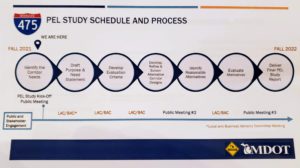
MDOT presented a timeline for the PEL study and anticipated construction rebuild of I-475 on Sept 15. (Photo by Tom Travis)
Flint remembers St. John’s and Floral Park neighborhoods
Both MDOT and HNTB representatives acknowledged the history and removal of the neighborhoods, St. John’s and Floral Park, when I-475 was originally built in the early 1970’s. Some residents present at the Sept. 15 meeting brought up the issue of racism and social equity.
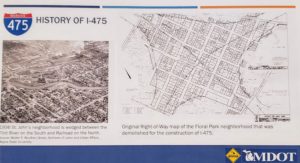
Historical photos of Flint neighborhoods destroyed in the 1970’s construction of I-475. The photos were part of 19-page packet of information presented to the public by MDOT on the I-475 rebuild project. (Photo by Tom Travis)
Included in MDOT’s presentation was a page depicting a 1936 photo of St. John’s neighborhood and the right-of-way map of the Floral Park neighborhood that was demolished for I-475. Both MDOT and HNTB representatives explained that the purpose of the year long PEL study is to avoid the mistakes of the past and to engage and listen to the community.

Residents stand over aerial view photos of I-475 pointing out landmarks and writing down their questions and suggestions on sticky notes for MDOT to consider. (Photo by Tom Travis)
The PEL study will include public community meetings throughout the city. MDOT officials have set up a communication through email and text for residents, available by clicking this link. The PEL study will last until November 2022 when HNTB will present their findings to MDOT.
MDOT and HNTB representatives want to hear from the Flint community
Clarissa McQuiston, a seven-year MDOT employee who recently transferred to the Davison MDOT office five months ago, explained that after the October 2020 presentation of a plan to rebuild I-475, “We heard a lot of comments from the public and we’ve gone to some community group meetings. We really want to hear what people have to say and to hear the history and the public’s perspective.”
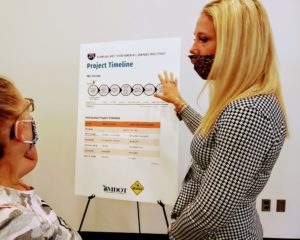
Clarissa McQuiston of MDOT explains to a member of the public the timeline for the I-475 rebuild project. (Photo by Tom Travis)
“You tell us – it’s your community,” McQuiston said. “What do you want to see? What’s the future? What does 475 look like to Flint in the future? That’s what this process [the 12-month PEL study] is about. We’re excited to kick off this process of listening to the community.
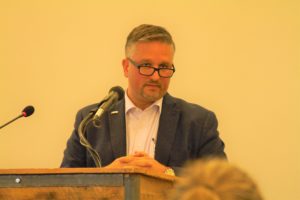
Tony Migaldi, project manager from the consulting firm HNTB speaking from the podium details the timeline of the PEL study. (Photo by Tom Travis)
“I have no idea what the final design will be but it will exciting to see where this year leads us, it will be public driven,” she said.
Tony Migaldi, a project manager at HNTB consulting firm for thirteen and a half years, said, “We will be working with the community and considering the social equity elements and that’s what we’re beginning tonight. To listen to those concerns and the stories.”
In response to the October 2020 presentation to rebuild I-475 Migaldi added, “We’re taking a step back and allowing the public to participate with us in the PEL study over the next 12 months. All design options are on the table. This process is about having the community to tell us what we should be looking for as we pull the alternatives together.”
Analysis of social economic and environmental impacts
MDOT and HNTB consulting firm representatives said the PEL study will allow Flint residents (referred to as “stakeholders” during the presentation) to engage and communicate their ideas.
A “screening process” will be used to identify a locally-accepted alternative for the I-475 corridor. The “screening process” will include:
Safety, cultural impacts, noise impacts, air quality impacts, pedestrian and non-motorized safety impacts, environmental justice impacts, social equity local and regional mobility needs, connectivity benefits for adjacent neighborhoods, economic impacts on local businesses, secondary and indirect impacts, impacts on local emergency responders, and consistency with approved local land uses plans.

A Flint Central Park neighborhood member sits with I-475 rebuild handouts taking notes as MDOT officials explain the project. (Photo by Tom Travis)
The anticipated engagement with the “stakeholders” (Flint residents) will include local advisory committee and business advisory committee meetings (TBA), local government meetings, small group/one-on-one meetings, meeting people where they are and public meetings, according to the MDOT representatives.
Anticipated purpose and need
In Wednesday’s presentation MDOT spokespersons said they anticipate addressing deteriorating infrastructure conditions; prioritizing the movement of people, including accommodating safer non-motorized travel; connecting neighborhoods with cultural, institutional, and commercial activity centers; and creating greater opportunities for economic development that support adopted master and land use plans.
Alternatives in road designs will be considered
In the photo a Common Urban Freeway and Narrowed urban Freeway are pictured showing an added bike lane and parking lane. Also, still in consideration is converting I-475 to an at-grade urban boulevard East Village Magazine reported on this intended change in October 2020.
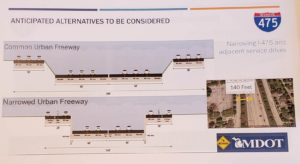
(Photo source: Michigan Department of Transportation MDOT.)
Another alternative in consideration is using a Diverging Diamond Interchange and Roundabout Interchange pictured below.
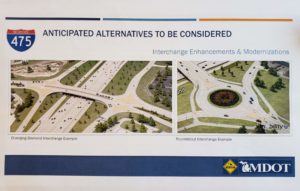
Ways for the public to connect with MDOT
MDOT and HNTB representatives provided several ways the public can share feedback and ways to connect with them in the coming months:
Email: MDOT-I475@michigan.gov
Visit the I-475 PEL study project website (bit.ly/I-475PEL).
Call MDOT at (517) 335-4381
The public can participate in a survey at the following website (arcg.is/1188L5)or by clicking this link online.
It was also announced that future updates MDOT will use the Public Involvement Management Application (PIMA). The public can sign up to be on that contact list for opportunities to engage with the I-475 PEL study by clicking this link at (bit.ly/I-475Contact).
EVM Managing Editor Tom Travis can be reached at tomntravis@gmail.com.



You must be logged in to post a comment.